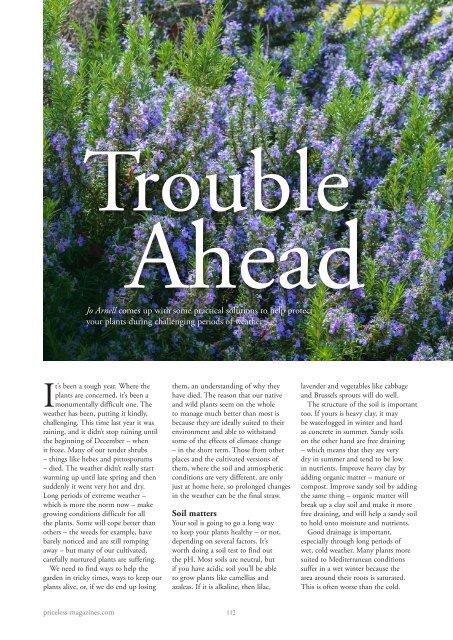Wealden Times | WT258 | November 2023 | Christmas Gift Supplement inside
The lifestyle magazine for Kent & Sussex - Inspirational Interiors, Fabulous Fashion, Delicious Dishes
The lifestyle magazine for Kent & Sussex - Inspirational Interiors, Fabulous Fashion, Delicious Dishes
You also want an ePaper? Increase the reach of your titles
YUMPU automatically turns print PDFs into web optimized ePapers that Google loves.
Trouble<br />
Ahead<br />
Jo Arnell comes up with some practical solutions to help protect<br />
your plants during challenging periods of weather<br />
It’s been a tough year. Where the<br />
plants are concerned, it’s been a<br />
monumentally difficult one. The<br />
weather has been, putting it kindly,<br />
challenging. This time last year it was<br />
raining, and it didn’t stop raining until<br />
the beginning of December – when<br />
it froze. Many of our tender shrubs<br />
– things like hebes and pittosporums<br />
– died. The weather didn’t really start<br />
warming up until late spring and then<br />
suddenly it went very hot and dry.<br />
Long periods of extreme weather –<br />
which is more the norm now – make<br />
growing conditions difficult for all<br />
the plants. Some will cope better than<br />
others – the weeds for example, have<br />
barely noticed and are still romping<br />
away – but many of our cultivated,<br />
carefully nurtured plants are suffering.<br />
We need to find ways to help the<br />
garden in tricky times, ways to keep our<br />
plants alive, or, if we do end up losing<br />
them, an understanding of why they<br />
have died. The reason that our native<br />
and wild plants seem on the whole<br />
to manage much better than most is<br />
because they are ideally suited to their<br />
environment and able to withstand<br />
some of the effects of climate change<br />
– in the short term. Those from other<br />
places and the cultivated versions of<br />
them, where the soil and atmospheric<br />
conditions are very different, are only<br />
just at home here, so prolonged changes<br />
in the weather can be the final straw.<br />
Soil matters<br />
Your soil is going to go a long way<br />
to keep your plants healthy – or not,<br />
depending on several factors. It’s<br />
worth doing a soil test to find out<br />
the pH. Most soils are neutral, but<br />
if you have acidic soil you’ll be able<br />
to grow plants like camellias and<br />
azaleas. If it is alkaline, then lilac,<br />
lavender and vegetables like cabbage<br />
and Brussels sprouts will do well.<br />
The structure of the soil is important<br />
too. If yours is heavy clay, it may<br />
be waterlogged in winter and hard<br />
as concrete in summer. Sandy soils<br />
on the other hand are free draining<br />
– which means that they are very<br />
dry in summer and tend to be low<br />
in nutrients. Improve heavy clay by<br />
adding organic matter – manure or<br />
compost. Improve sandy soil by adding<br />
the same thing – organic matter will<br />
break up a clay soil and make it more<br />
free draining, and will help a sandy soil<br />
to hold onto moisture and nutrients.<br />
Good drainage is important,<br />
especially through long periods of<br />
wet, cold weather. Many plants more<br />
suited to Mediterranean conditions<br />
suffer in a wet winter because the<br />
area around their roots is saturated.<br />
This is often worse than the cold.<br />
priceless-magazines.com 112


















